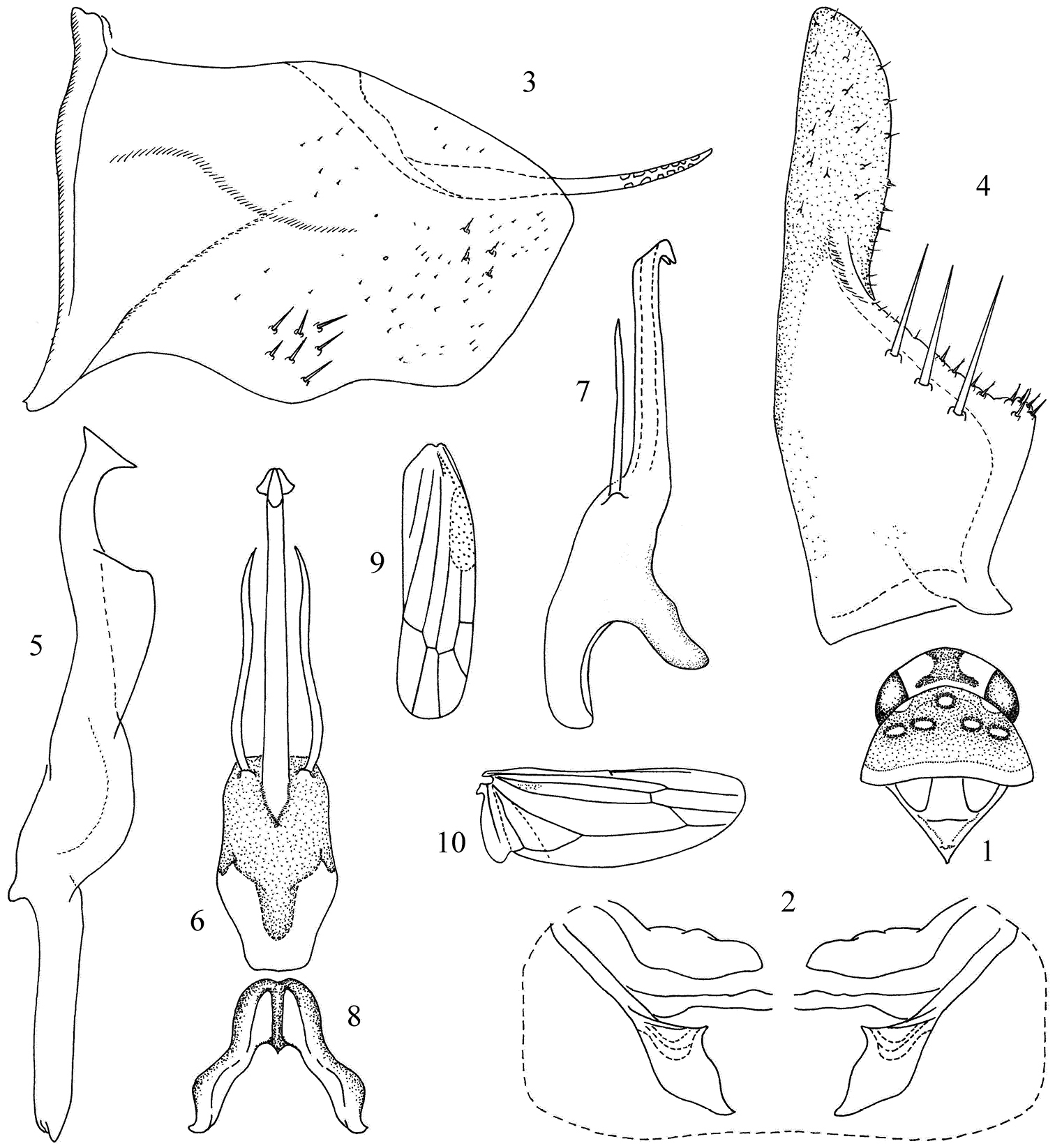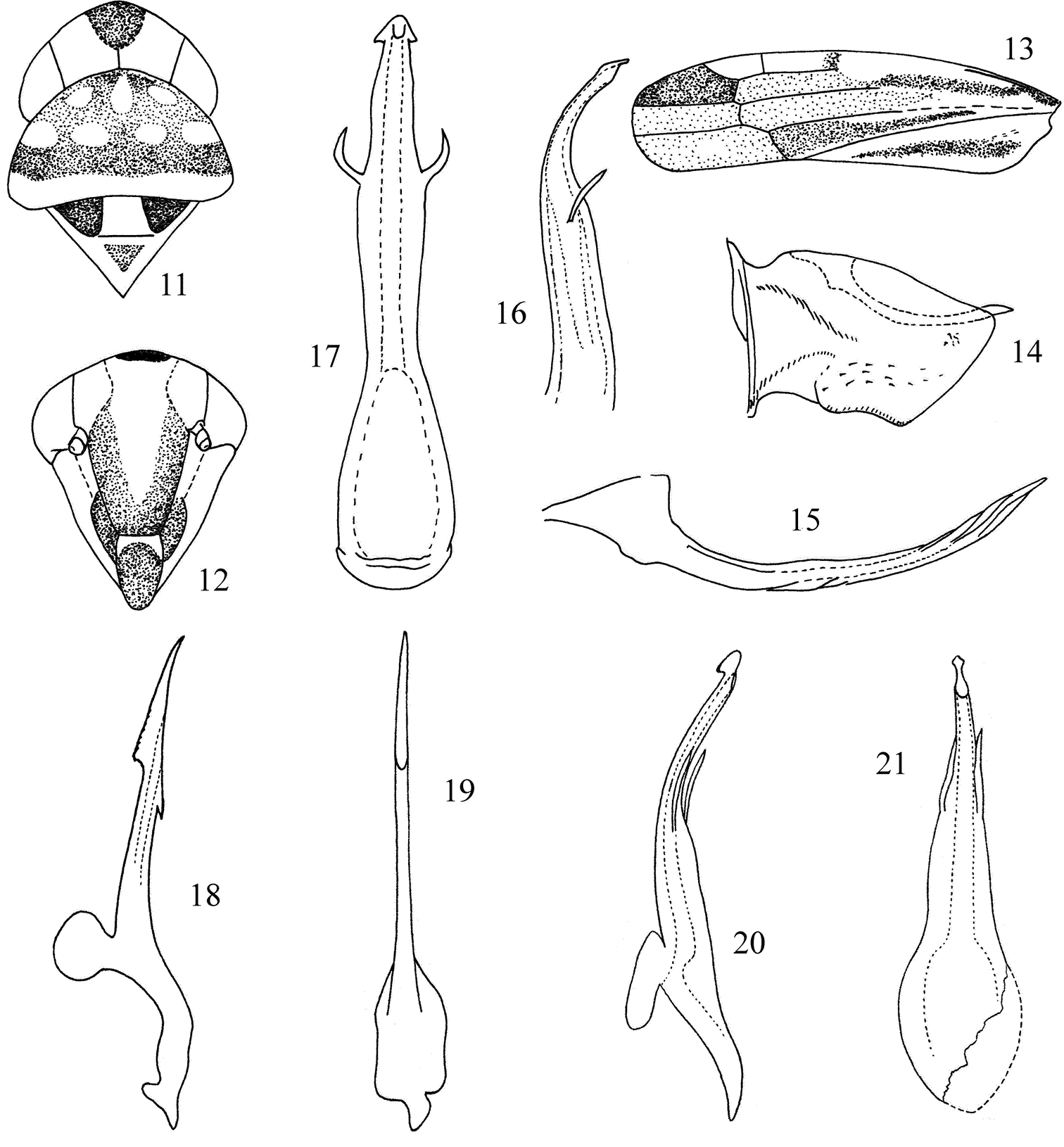






(C) 2012 Yuehua Song. This is an open access article distributed under the terms of the Creative Commons Attribution License 3.0 (CC-BY), which permits unrestricted use, distribution, and reproduction in any medium, provided the original author and source are credited.
For reference, use of the paginated PDF or printed version of this article is recommended.
Seriana menglaensis sp. n. (Hemiptera: Cicadellidae: Typhlocybinae: Erythroneurini) is described and illustrated from Southwest China. Seriana equata (Singh, 1969) is recorded for the first time from China.
Hemiptera, morphology, taxonomy
The leafhopper genus Seriana was established by
Only two species, Seriana indefinita Dworakowska, 1971 from Guangzhou and Seriana ochrata Dworakowska, 1971 from Taiwan were so far reported from China. We describe a new species from Yunnan Province, China and provide illustrations for both the new species and Seriana equata (Singh) recorded for the first time from China.
Methods and materialsThe specimens were obtained by sweep net method and were studied under Olympus SZX7 and CX41 microscopes. Morphological techniques and terminology follow
| 1 | Aedeagus with paired processes | 2 |
| – | Aedeagus with unpaired processes (Figs 18, 19) | Seriana indefinita Dworakowska |
| 2 | The paired processes arising from the base of aedeagual shaft (Figs 6, 7) | Seriana menglaensis sp. n. |
| – | The paired processes arising from the midlength of aedeagual shaft | 3 |
| 3 | The paired processes shorter, hook-like (Figs 16, 17) | Seriana equata (Singh) |
| – | The paired processes longer, finger-like (Figs 20, 21) | Seriana ochrata Dworakowska |
urn:lsid:zoobank.org:act:80FEEE6B-1EEA-491F-AE03-7EBADD04AF0F
http://species-id.net/wiki/Seriana_menglaensis
Figures 1–10General color fuscous. Head (Fig. 1) with vertex dirty yellow, with an irregular brown spot at anterior margin medially; eyes black. Pronotum (Fig. 1) with five whitish oval impressed patches near anterior margin. Forewing light testaceous, without markings; brochosome field blackish brown.
Head (Fig. 1) distinctly narrower than pronotum; vertex bluntly rounded.
Abdominal apodemes (Fig. 2) small, acuminate apically, not extended beyond hind margin of 3rd sternite.
Pygofer lobe (Fig. 3) broad, with distinct oblique dorsolateral internal ridge, numerous macrosetae at lower basal angle. Pygofer dorsal appendage very long and fused with dorsal margin of pygofer. Subgenital plate (Fig. 4) with three long macrosetae and short rigid setae at upper margin subbasally; several microsetae scattered on apical portion. Style (Fig. 5) long, apex truncate; preapical lobe large. Connecitve (Fig. 8) Y-shaped, stem strong, central lobe absent. Aedeagus (Figs 6, 7) with shaft long and straight, with two pairs processes, one pair very long, arising from basolateral part of shaft; another pair placed apically very short, lamellate; gonopore at apex, on ventral margin, dorsal apodeme short, weakly expanded.
Seriana menglaensis Song & Li, sp. n. (♂) 1 Head and thorax, dorsal view 2 Abdominal apodemes 3 Pygofer lobe, lateral view 4 Subgenital plate 5 Style 6 Aedeagus, ventral view 7 Aedeagus, lateral view 8 Connective 9 Forewing 10 Hind wing.
Body length males 3.2 mm.
Holotype, male, China: Yunnan Prov., Mengla County, at light, 23 July 2008, coll. Yuehua Song. Paratype: one male, same data as holotype.
The new species is similar to Seriana ochrata
The new species is named after its type locality: Mengla.
http://species-id.net/wiki/Seriana_equata
Figures 11–17One male, China: Yunnan Prov., Xishuangbanna, Original Forest Park, 21 July 2008, coll. YUEHUA SONG; one male, China: Henan Prov., Luanchuan, Heyu, 19 August 2008, coll. JIANDA LI.
Seriana equata (Singh, 1969) rec. n. (after
Grasses, potato, black gram, cowpea, Egyptian clover, groundnut, linseed, lucerne, musk melon, spinach, sweet potato, sunnhemp (
India; China (Henan, Yunnan).
The project was supported partly by the “Scientific Research Foundation for Doctor’s Degree Members, Guizhou Normal University: Taxonomic Study of Erythroneurini and Zyginellini from South China Karst Area”, the Social Development and Science & Technology of People’s Livelihood Program of Guiyang City (No. 201110362), the Key Technologies R&D Program of Guizhou Province (SY[2010]3068) and the Guizhou Provincial Natural Science Foundation of China (No. [2010]2063).

